Ulm Synagogue by Kister Scheithauer Gross
German architects Kister Scheithauer Gross used Jewish symbol the Star of David to create patterned windows in the limestone walls of this synagogue in Ulm, Germany.
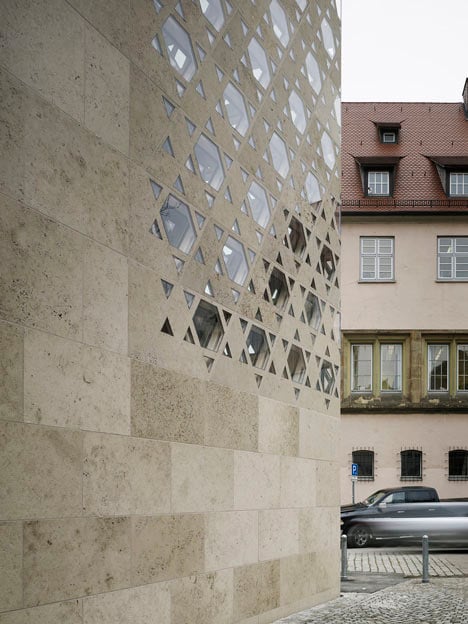
The town's original synagogue was torn down in 1938 as part of the Kristallnacht, or "night of broken glass", a series of attacks on Jewish community buildings within Nazi Germany.
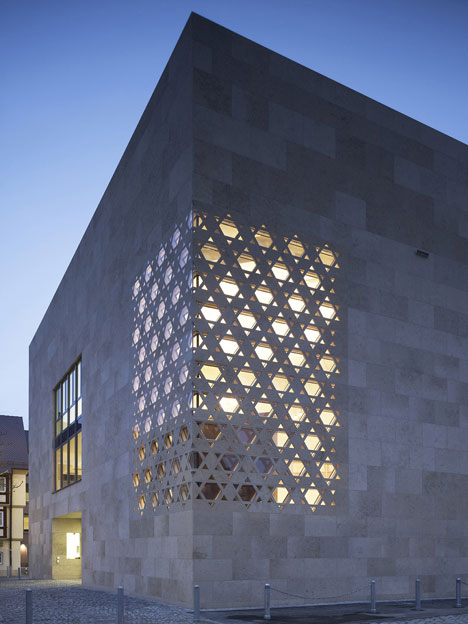
Kister Scheithauer Gross (KSG) won a competition in 2010 to reinstate the building beside the site where its predecessor once stood.
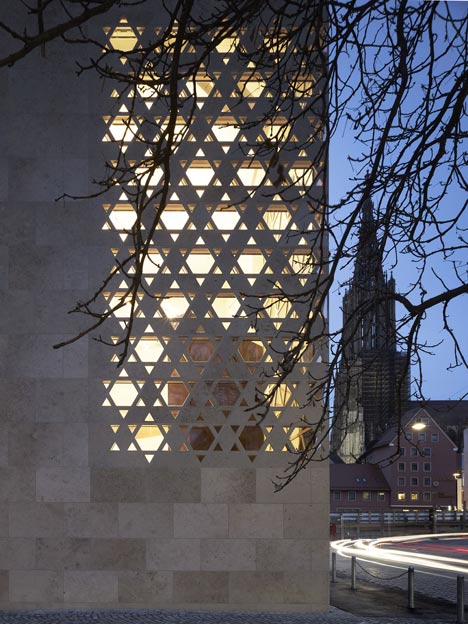
"This position is historical," said architect Susanne Gross. "In the Kristallnacht in 1938, the former synagogue was destroyed. After World War II, a secular building was constructed in the space. The synagogue and the Jewish community lost its ancestral place in the centre of Ulm."
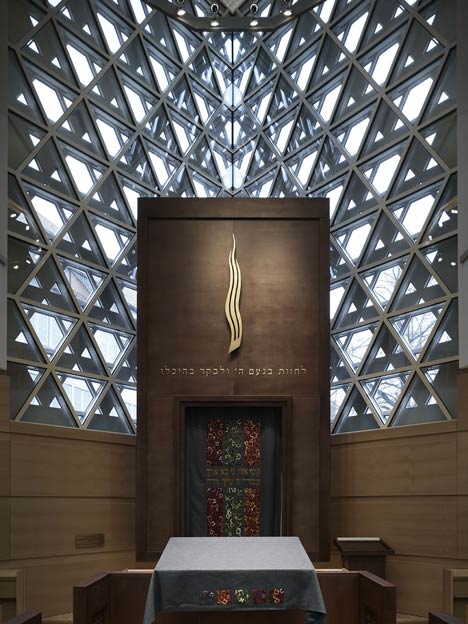
"The construction of the current synagogue has opened a new site, in the middle of the square," she added. "It is as though the synagogue has taken a step forward from its former position; it has reclaimed its location."
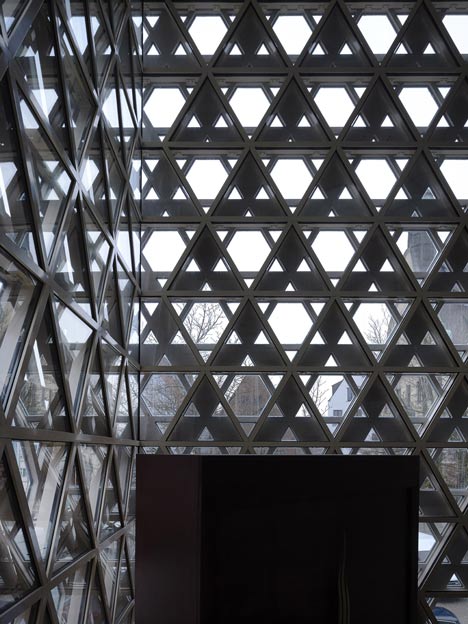
Both a synagogue and a Jewish community centre are contained within the cube, which stands apart from other buildings and faces out onto the town square. "With no constructed borders, it stands abrupt and solitary on the Weinhof," said Gross.
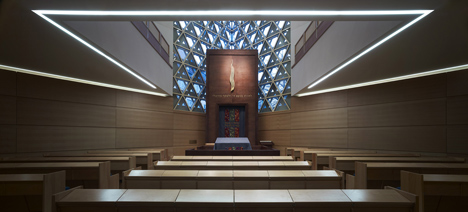
The stone walls make reference to the traditional Jerusalem limestone of many buildings in Israel, but the architects had to source a more frost-resistant stone to suit the colder climate. "We searched for a limestone with a similar but frost-resistant appearance and found the Dietfurt limestone that is mined in Bavarian Dietfurt, about 110 kilometres away from Ulm," said KSG's Farina Kast.
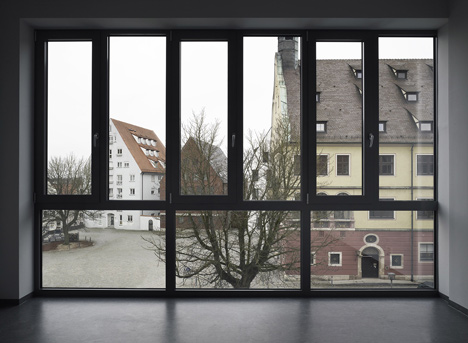
Most rooms inside the building are laid out on an orthogonal grid. However the 125-seat prayer rooms points south-east towards Jerusalem - a typical feature in synagogue design.
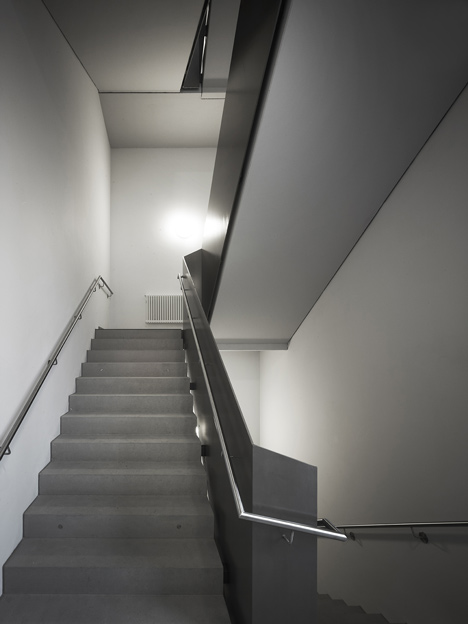
"In the competition design, the prayer room was faced eastward. After we won and when the close collaboration with the client began, the Rabbi expressed the wish to have the prayer room aligned towards Jerusalem," said Kast.
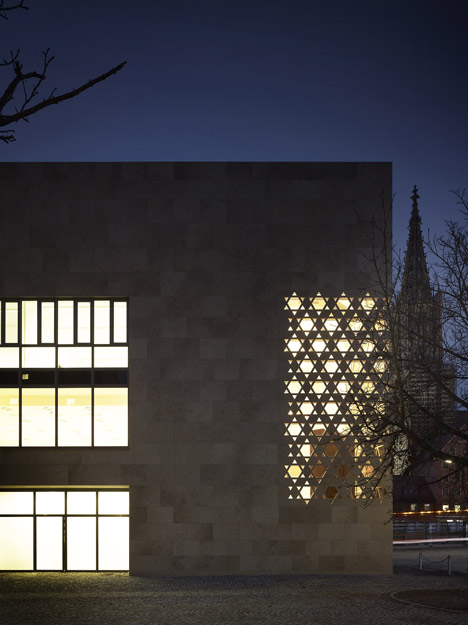
The sacral chamber is positioned at the end of this space, behind the star-shaped windows.
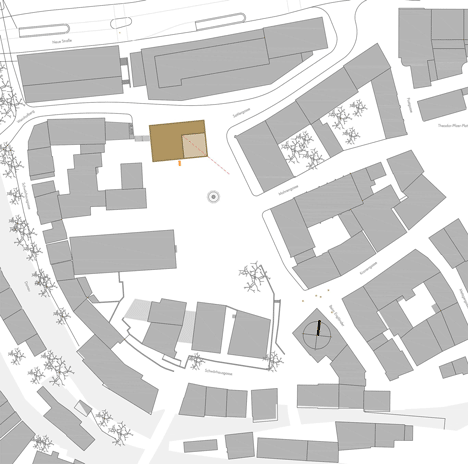
Above: site plan
Other Jewish community buildings we've featured include a ritual bathhouse in Mexico and a community centre in Mainz, Germany.
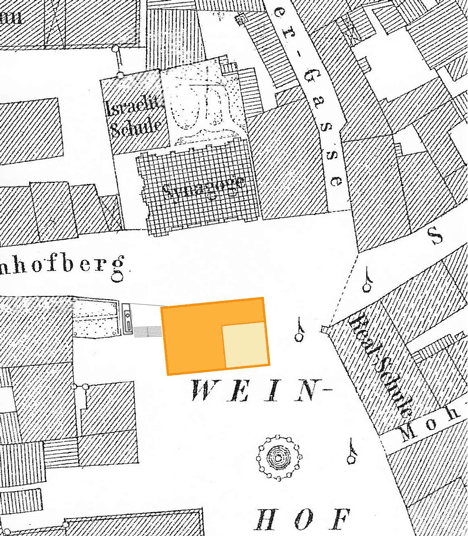
Above: historical site plan
Photography is by Christian Richters.
Here's some more information from the architects:
ksg Completes Ulm Synagogue
kister scheithauer gross architects and urban planners (ksg) have completed the community centre and synagogue for the Jewish community of Ulm.
In 2009, the Israelite Religious Community in Württemberg (IRGW) decided to build a new synagogue for its orthodox community in Ulm and, together with the city of Ulm, initiated a competition. The city placed the building site in the middle of the Weinhof, just a stone’s throw from the former synagogue, which was destroyed during Kristallnacht.
"The team from Cologne succeeded in enriching this highly sensitive location in the city of Ulm, without detracting from its unique character," said the city’s head of construction, Alexander Wetzig, following the jury’s decision in January 2010.
In the completed build, the cuboid is lower and shorter than initially planned during the competition. It is now 24 meters wide, 16 deep and at 17 meters high, much lower than the nearby Schwörhaus.
All the spaces of the community centre and the synagogue are joined in the smooth structure: foyer, synagogue, Mikvah (ritual bath), meeting hall, school and administrative rooms as well as the child day care centre with an enclosed outdoor playing area, which is directly above the sacral room.
The rooms are arranged orthogonally. Only the synagogue follows the line of the only, free-standing support in the building, in a diagonal direction. The direction facing south-east has an overlying religious meaning behind it: its geographical direction is directly towards Jerusalem, the spiritual and religious centre of Judaism.
The diagonal room layout creates a corner window in the sacral room, which plays with a pattern of the Star of David as a space framework. With 600 openings, the synagogue is illuminated from many points, with the focal point being the liturgical centrepiece; the Torah shrine. The perforations in the façade created with a high-pressure water jet, illuminate the shrine inside and project the idea of the synagogue outwards.
The interior fittings of the synagogue are partially based on ksg plans, such as the dodecagon holder, a symbol for the twelve lines of the people of Israel. Rabbi Shneur Trebnik, together with the IRGW representatives, selected the seating and ordered the construction of the Torah shrine, including the bimah, a raised platform with a lectern, from which the Torah is dictated. All three elements were constructed in Israel.
The prayer room offers space for 125 people, including 40 spaces in the women’s gallery. The building was full to capacity during the opening on Sunday, December 2nd 2012. The 300 invited guests included former Jewish citizens of Ulm, who fled during World War II. Speeches were held by Federal President of Germany Joachim Gauck, Prime Minister of Baden-Württemberg Winfried Kretschmann, the President of Central Council of Jews in Germany Dieter Graumann and Israel’s ambassador to Germany Yacov Hadas-Handelsman.
Client: Israelite Religious Community of Württemberg statutory corporation Hospitalstraße 36, 70174 Stuttgart, Germany
Board of directors: Barbara Traub, Susanne Jakubowski, Michael Kashi
Occupant: Rabbi Shneur Trebnik and the orthodox Jewish community of Ulm
Authorities: City of Ulm, Germany
Mayor: Ivo Gönner
Head of construction: Alexander Wetzig
Architects: kister scheithauer gross architects and urban planners, Cologne
Design/responsible partner: Prof. Susanne Gross
Project manager, artistic director: Grzegorz Rybacki
Team: Fritz Keuten, Matthes Langhinrichs, Stefan Schwarz, Paul Youk
Project management: nps Bauprojektmanagement GmbH, Ulm, Germany
General contractor: Matthäus Schmid Bauunternehmen GmbH & Co. KG, Baltringen, Germany
Consultants in the competition and design phase
Structural analysis: Dr.-Ing. W.Naumann & Partner, Köln
Thermo gravimetric analysis: ZWP AG, Köln
Acoustics: ISRW Dr.-Ing. Klapdor GmbH, Düsseldorf
Building physics: Ing.-Büro für Bauphysik Heinrichs, Köln
Fire safety: BFT Cognos, Aachen
Competition: 11/2009
Performance time: 2010-2012
Start of construction: 03/2011
Completion: 12/2012
Gross floor space: 1.980 m²
Performance phases: 1 – 4 plus artistic direction and master details
Construction costs: 4.6 million euros